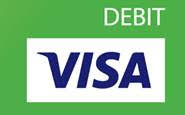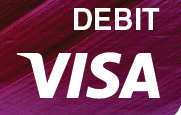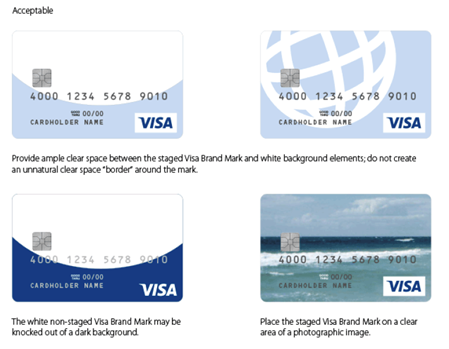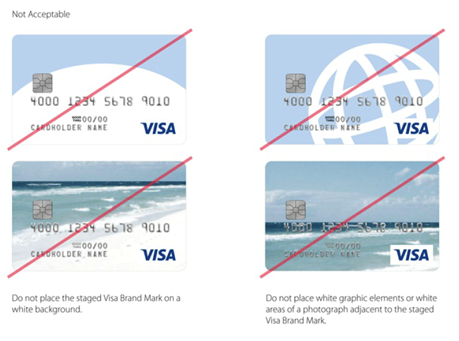Card design guidelines
What are the regulations regarding card designs.
Overview
This article describes the process and requirements for designing cards (physical, virtual, and digital) as well as the collateral that goes along with the physical card, such as paper carrier, packaging, and envelope.
For physical cards, we offers two different options:
- Standard
- Custom
The standard card has limited customization options but also takes less time to produce. These cards typically take six weeks from design approval to live production.
The custom card allows for almost unlimited customization options (for example, materials, texture, colors, design elements, and so on), but they also takes much longer to produce. Custom cards can take around 16 weeks from design approval to live production.
In order to go to market as quickly as possible, we recommend that you start with the standard card and transition to a custom card once your program is live.
| Card type | Timeline | Card design | Material |
|---|---|---|---|
| Standard | 6 weeks | Client designed front | White plastic |
| Custom | 16 weeks | Client designed front and back | Client choice |
Standard cards
Standard cards are produced using a method called Print-On-Demand (POD) which allows for fixed pricing per card and no minimum order size. Because the card stock used for POD is already held in inventory at the card printer, clients can get to market as quickly as possible.
When printing standard cards, clients can expect it to take roughly 3-4 weeks to ship cards to initial cardholders after the design is approved by the card printer. Standard cards are limited to the following:
- Card is white PVC plastic (that is, no color core, no metal cards, and so on).
- Back of the card must be solid black.
- Card is full gloss (that is, no special finishes like matte, varnish, and so on).
- Card cannot be personalized with engraving or a laser cut.
Custom cards
If you choose to go with custom printing, we will work with you and our card printing and fulfillment partners to clarify the pricing details specific to your design and your timeline.
Custom cards have a minimum purchase quantity and pricing depends on the specifics of your order. The all-in per-unit cost to print and ship a card to an end-customer can vary based on several variables, such as:
- Card stock material and color
- Personalization techniques
- Collateral/packaging
- Manual fulfillment of the card order
- Shipping fees
Design options and specifications
Card orientation
Cards can be oriented horizontally or vertically. The number of characters in the cardholder name field is limited by the card orientation as follows:
- Horizontal card—maximum of 26 characters
- Vertical card—maximum of 19 characters
Other card design specifications
Other Card Specifications can be found XXXXXXXXXXX here XXXXXXXX XXX.
Card information can be placed on the front or back of the card based on the guidelines in the following table.
| Element | Front or back | Font/logo |
|---|---|---|
| PAN (16-digit card number) | Either | 12-14 pt sans serif |
| Cardholder Name | Either | 9 - 12 pt sans serif |
| Company Name (optional) | Either | 9 - 12 pt sans serif |
| Expiration Date | Either | 9 - 12 pt sans serif |
| Contactless Logo | Either | ![Contactless logo] (https://files.readme.io/cce029f-contactless.png) |
| Issuer Statement | Back | 1-4 pt sans serif |
Network branding guidelines and requirements
Mastercard
Mastercard symbol
The full-color Mastercard symbol must be present on the card front as described in Chapter 2 (page 64) of theMastercard Card Design Standards. The Mastercard premium brand mark can only be used with Bond’s consumer credit programs.
Further details are available in Bond’s Mastercard Design Guide.
Binocular or white glow/black shadow treatment
If the background does not provide sufficient contrast or visually interferes with the Mastercard symbol, a binocular treatment or a white glow or black shadow treatment can be used.
| Treatment | Description |
|---|---|
| Binocular treatment | A 0.4 mm 100% white or black line surrounds the Mastercard Symbol or the interlocking circles portion of the Mastercard logo. |
| White glow/black shadow | A 0.4 mm 100% white or black line surrounds the Mastercard Symbol or the interlocking circles portion of the XXXXXXXXXXXXXXXXXXXXXXX |


Mastercard debit silver hologram
The Mastercard debit silver hologram must be present on the back of a Debit Mastercard card. It can be positioned anywhere except behind the chip safety area. For more information, see page 111 in the Mastercard Card Design Standards manual.
Product Identifiers
| Consumer / Business | Credit / Debit | Regulation |
|---|---|---|
| Consumer | Credit | Must have the "world" identifier placed on either the front or back of the card. |
| Consumer or Business | Debit | The "Debit" identifier must be placed on the front of the card in one of the specified locations, see page 113in the Mastercard Card Design Standards. |
| Business | Credit | Must have the "Business" identifier placed on either the front or back. |
For further details, see Mastercard design assets.
Visa
Staged vs. Non-staged
Staged—the blue Visa logo in the bottom right corner of the card is surrounded by a white “knockout box”. The Visa logo does not need to be included in your design file.
Non-Staged—the Visa logo must be white and printed on a colored card background. The Visa logo must be included in your card design and the printer will print it on the plastic at the time of personalization.
| Template | Explanation | Example |
|---|---|---|
| Staged | The card has a pre-printed blue Visa logo that requires a white knockout box around the logo. There must be contrast between the white box and the background behind it. |  |
| Non-staged | The printed Visa logo must be white and there must be a color contrast between the logo and the card background. The Visa logo must be included in the card design file. |  |
Acceptable and unacceptable card designs
| Acceptable | Unacceptable |
|---|---|
 |  |
Product Identifier
The "Debit" identifier must be placed directly above the Visa logo in all capital letters.
For further details, see:
Design file specifications
In order to proof your card design, our card printing vendor requires the design file to be shared in a specific format.
When creating your design file, adhere to the guidelines in the following table.
| .ai or .eps (vector format) | .psd or .tif (hi-res format) | |
|---|---|---|
| Size | At least 3.5” x 2.24“ (card size is 3.375” x 2.125”) | At least 3.5” x 2.24“ (card size is 3.375” x 2.125”) |
| Color mode | CMYK | CMYK |
| Layered artwork | Put each design element in separate layer | Do not flatten layers |
| Fonts | Fonts converted to outlines or font files included | Names of fonts used or font files included |
| Pantone colors | If Pantone colors are used, they are converted to CMYK during formatting | Pantone colors may be used (if applicable) |
| Other | NA | At least 600 DPI resolution |
Collateral and packaging
Collateral refers to the material that gets shipped along with the physical card. Cards cannot be shipped alone, so it is typically affixed to a paper carrier and stuffed in an envelope to be mailed to your customer. Bond supports several different packaging options and will recommend standard or custom collateral depending on your budget and timeline.
Carriers
Carriers are standard 8.5”x11” paper, folded into thirds. The card is affixed to the right side of the middle panel, as indicated in the template layout.
| Name | Background | 1- or 2-sided | Text and logo color | Additional notes |
|---|---|---|---|---|
| Black carrier | White | Either | Black only | Only text is allowed to the left of where the card is affixed and on bottom panel If 2-sided, only text is permitted on back |
| Generic dual interface (DI) carrier | Existing graphic | Either | Black only | Only text allowed to the left of where the card is affixed and on bottom panel If 2-sided, only text is permitted on back |
| Custom carrier | Client-designed | Either | Client designed | * Minimum 1,000 volume order |
For further details, see:
Envelope
The regular envelope is a standard, white #10 envelope. It has two windows through which you can see the address of the cardholder and the return address printed on the carrier.
Customizations to the envelope are limited to printing that can be done on the #10 white envelope. Custom carriers must be pre-purchased with a minimum volume order of 1,000.
For further details, see #10 2 window envelope.
Activation sticker
Activation stickers are useful for providing your customers with instructions on how to start using the card. Adding an activation sticker is optional.
Generic stickers can only have black text on a white background using a standard sans serif font, whereas custom stickers allow for both color and font customization.
For further details, see:
Custom packaging
Custom packaging for the card is available in many different forms. Most commonly, clients interested in designing custom packaging use our packaging vendor’s booklet, pop-up, or slider box dielines.
We’ll work with you and our packaging partner to design and create a custom package that will stand out and represent your brand. During this process, we’ll also provide guidance on pricing specific to your design and your timeline. Timelines for fulfillment vary depending on the complexity and level of customization desired.
For further details, see Custom packaging examples.
Digital and virtual card designs
A virtual card is one that is established primarily for ecommerce and/or mail order/telephone order purchases. A virtual card provides the account holder with the information necessary to complete a card-not-present purchase. A virtual card’s information is typically accessible and displayed in a mobile or web app.
A digital card is the representation of a card (virtual or physical) for use within digital services or a digital wallet (for example, your Apple Wallet).
Virtual card design requirements differ from a digital card held in a digital wallet. For requirements for card art used within digital environments and devices, see the following guides:
Updated over 3 years ago
